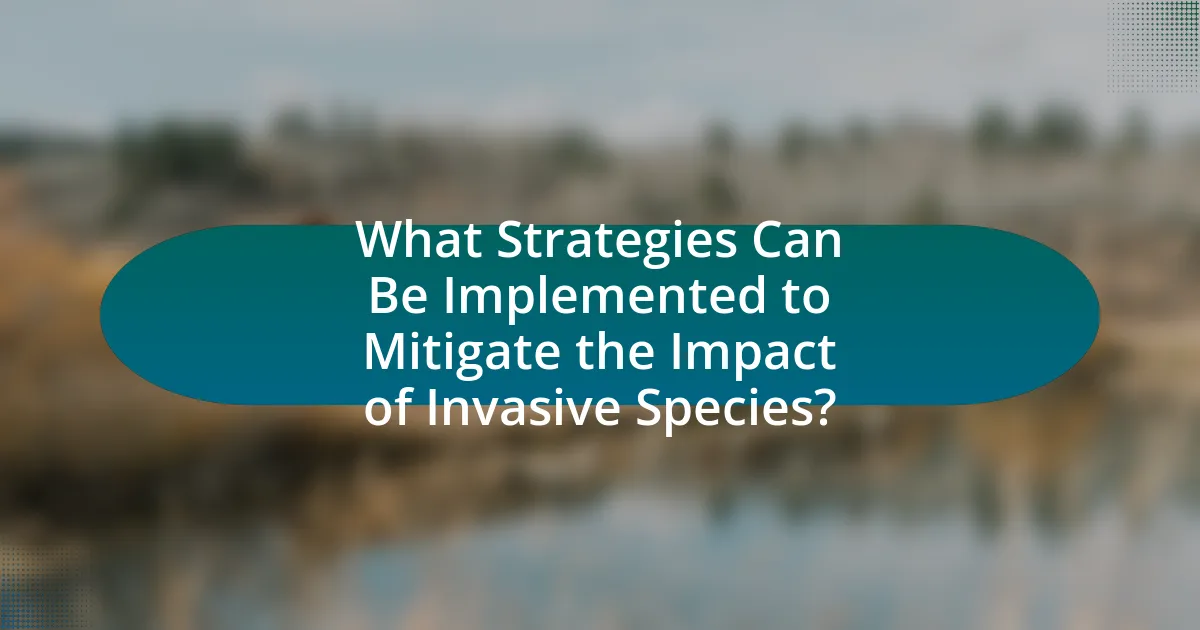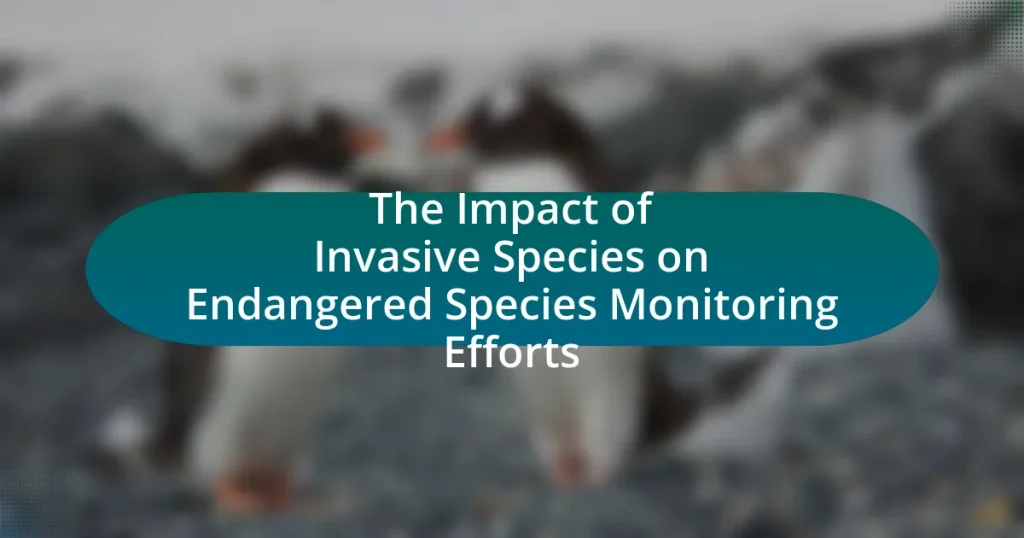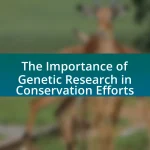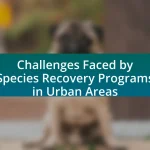Invasive species are non-native organisms that disrupt local ecosystems and threaten biodiversity, particularly impacting endangered species. This article examines the characteristics of invasive species, their differences from native species, and the specific threats they pose to endangered populations through competition for resources and habitat alteration. It also highlights the challenges invasive species create for monitoring efforts, including skewed population assessments and data collection difficulties. Effective strategies for mitigating their impact, such as prevention, early detection, and public awareness, are discussed, emphasizing the importance of collaborative approaches in conservation efforts.

What are Invasive Species and Their Characteristics?
Invasive species are non-native organisms that, when introduced to a new environment, disrupt local ecosystems and outcompete native species. These organisms often exhibit rapid reproduction, high adaptability, and a lack of natural predators in their new habitats, which allows them to thrive and spread quickly. For example, the zebra mussel, introduced to North America in the 1980s, has caused significant ecological and economic damage by outcompeting native mussels and clogging water intake systems. The characteristics of invasive species, such as their aggressive growth and reproductive strategies, contribute to their ability to alter habitats and threaten biodiversity, particularly impacting endangered species and complicating monitoring efforts.
How do invasive species differ from native species?
Invasive species differ from native species primarily in their origin and ecological impact. Invasive species are non-native organisms introduced to an ecosystem, often causing harm to the environment, economy, or human health, while native species are those that naturally occur in a specific region and have adapted to the local environment over time. For example, the introduction of the zebra mussel in North America has led to significant ecological disruption, outcompeting native mussel species and altering aquatic ecosystems. This distinction is crucial for understanding the challenges invasive species pose to biodiversity and conservation efforts, particularly in monitoring endangered species, as invasive species can threaten their survival and disrupt their habitats.
What traits make a species invasive?
Invasive species typically possess traits such as rapid reproduction, high dispersal ability, and adaptability to various environments. These characteristics enable them to establish and spread quickly in new habitats, often outcompeting native species for resources. For instance, the zebra mussel can reproduce rapidly and thrive in diverse aquatic environments, leading to significant ecological and economic impacts. Additionally, invasive species often lack natural predators in their new environments, allowing their populations to grow unchecked, which further exacerbates their invasive potential.
How do invasive species spread in new environments?
Invasive species spread in new environments primarily through human activities, natural dispersal mechanisms, and ecological interactions. Human activities such as global trade, travel, and the release of pets contribute significantly to their introduction and establishment in non-native habitats. For instance, the introduction of the zebra mussel to North America occurred via ballast water from ships, demonstrating how maritime transport facilitates the spread of invasive species. Additionally, natural dispersal methods, including wind, water currents, and animal movement, allow invasive species to colonize new areas. Research indicates that invasive species can outcompete native species for resources, further enhancing their spread and establishment in diverse ecosystems.
Why are invasive species a concern for ecosystems?
Invasive species are a concern for ecosystems because they disrupt native biodiversity and alter habitat dynamics. These species often outcompete native organisms for resources such as food and space, leading to declines in native populations. For example, the introduction of the zebra mussel in North America has caused significant ecological and economic impacts by outcompeting native mussels and altering aquatic ecosystems. Additionally, invasive species can introduce diseases that native species are not equipped to handle, further threatening their survival. The overall result is a decrease in ecosystem resilience and functionality, which can have cascading effects on food webs and ecosystem services.
What impact do invasive species have on biodiversity?
Invasive species significantly reduce biodiversity by outcompeting native species for resources, disrupting ecosystems, and altering habitats. For instance, the introduction of the zebra mussel in North America has led to the decline of native mussel populations, resulting in decreased species diversity in freshwater ecosystems. Studies indicate that invasive species can cause extinction rates of native species to increase by up to 50%, highlighting their detrimental impact on biodiversity.
How do invasive species alter habitat conditions?
Invasive species alter habitat conditions by disrupting native ecosystems, leading to changes in species composition, nutrient cycling, and habitat structure. For instance, invasive plants can outcompete native vegetation for resources, resulting in reduced biodiversity and altered soil chemistry. A study published in the journal “Ecological Applications” found that invasive species can decrease native plant diversity by up to 50%, which in turn affects the entire food web and habitat stability. Additionally, invasive animals can modify physical environments, such as through burrowing or predation, further impacting native species and their habitats.

How do Invasive Species Affect Endangered Species?
Invasive species negatively affect endangered species by competing for resources, predating on them, and disrupting their habitats. For instance, invasive plants can outcompete native vegetation, reducing food and shelter for endangered animals. Additionally, invasive predators, such as rats or cats, can decimate populations of vulnerable species, leading to further declines. A study published in the journal “Biological Conservation” found that invasive species are a significant factor in the extinction of 42% of threatened and endangered species globally, highlighting the critical impact of these non-native organisms on biodiversity.
What specific threats do invasive species pose to endangered species?
Invasive species pose specific threats to endangered species by competing for resources, predation, and habitat alteration. These non-native species often outcompete endangered species for food, space, and other essential resources, leading to population declines. For example, the introduction of the brown tree snake in Guam has resulted in the extinction of several native bird species due to predation. Additionally, invasive plants can alter habitats, making them unsuitable for native species; for instance, the spread of kudzu in the southeastern United States has smothered native vegetation, disrupting local ecosystems. These interactions can significantly hinder the survival and recovery efforts of endangered species.
How do invasive species compete with endangered species for resources?
Invasive species compete with endangered species for resources by outcompeting them for food, habitat, and other essential resources. This competition often leads to a decline in the population of endangered species, as invasive species can reproduce rapidly and adapt to various environments, thereby monopolizing resources. For instance, studies have shown that invasive plants can overshadow native vegetation, reducing the availability of light and nutrients for endangered plant species, which can ultimately lead to their extinction. Additionally, invasive predators can directly threaten endangered species by preying on them or competing for the same food sources, further exacerbating the decline of vulnerable populations.
What role do invasive species play in the decline of endangered populations?
Invasive species significantly contribute to the decline of endangered populations by outcompeting native species for resources, disrupting ecosystems, and introducing diseases. For instance, the introduction of the brown tree snake in Guam has led to the extinction of several native bird species due to predation and competition for food. Additionally, invasive plants can alter habitats, making it difficult for endangered species to thrive. Research indicates that invasive species are responsible for approximately 42% of the documented extinctions of native species, highlighting their detrimental impact on biodiversity.
How can invasive species disrupt monitoring efforts for endangered species?
Invasive species can disrupt monitoring efforts for endangered species by outcompeting them for resources, leading to population declines that complicate data collection. For instance, invasive plants can alter habitats, making it difficult for researchers to locate and observe native endangered species. Additionally, invasive predators can directly threaten the survival of these species, skewing population data and hindering accurate assessments of their status. Studies have shown that invasive species can reduce the abundance and distribution of native species, which in turn affects the reliability of monitoring programs aimed at conservation efforts.
What challenges do invasive species create for data collection?
Invasive species create significant challenges for data collection by disrupting ecosystems and altering species interactions. These disruptions can lead to misinterpretation of data related to native species populations, as invasive species often outcompete or prey on them, skewing population estimates and habitat assessments. For instance, the introduction of the zebra mussel in North America has drastically changed aquatic ecosystems, complicating the monitoring of native fish populations. Additionally, invasive species can introduce diseases that affect native species, further complicating data collection efforts by obscuring the health status of endangered species. This complexity necessitates more sophisticated methodologies and increased resources for accurate data collection and analysis.
How do invasive species affect the accuracy of population assessments?
Invasive species significantly distort the accuracy of population assessments by competing with native species for resources, leading to miscalculations in population sizes. When invasive species proliferate, they can outcompete, prey on, or introduce diseases to native populations, which skews data collected during assessments. For instance, studies have shown that the presence of invasive plants can reduce the visibility and detectability of native species, resulting in underestimation of their populations. Additionally, invasive species can alter habitats, making it difficult for researchers to establish baseline conditions necessary for accurate assessments. This complexity necessitates more sophisticated methodologies and can lead to erroneous conclusions about the health and viability of native populations.

What Strategies Can Be Implemented to Mitigate the Impact of Invasive Species?
To mitigate the impact of invasive species, effective strategies include prevention, early detection, rapid response, and management. Prevention involves implementing strict regulations on the importation of non-native species, as seen in the U.S. Lacey Act, which prohibits the trade of invasive species. Early detection can be achieved through monitoring programs that utilize citizen science and technology, such as eDNA sampling, which has proven effective in identifying invasive species before they establish. Rapid response strategies, including eradication efforts, have been successfully employed in cases like the removal of the invasive brown tree snake in Guam, which helped protect native bird populations. Ongoing management practices, such as habitat restoration and public education campaigns, further support the reduction of invasive species impacts on ecosystems and endangered species.
What management practices are effective in controlling invasive species?
Effective management practices for controlling invasive species include prevention, early detection, rapid response, and long-term management strategies. Prevention involves measures such as strict regulations on the importation of potentially invasive species, which can significantly reduce the risk of introduction. Early detection and rapid response are critical; monitoring programs that utilize technology, such as remote sensing and environmental DNA analysis, can identify invasive species before they establish. Long-term management strategies often involve integrated approaches, including biological control, habitat restoration, and public education campaigns, which have been shown to be effective in various case studies, such as the successful eradication of the invasive brown tree snake in Guam through a combination of trapping and public awareness efforts. These practices collectively contribute to the reduction of invasive species impacts on native ecosystems and endangered species.
How can early detection and rapid response help protect endangered species?
Early detection and rapid response are crucial for protecting endangered species by enabling timely interventions that mitigate threats, particularly from invasive species. When invasive species are identified early, conservationists can implement control measures to reduce their impact on native populations, thereby preserving biodiversity. For instance, studies have shown that rapid response efforts can significantly decrease the establishment of invasive species, which, according to the U.S. Fish and Wildlife Service, can lead to a 50% reduction in the decline of at-risk species. This proactive approach not only safeguards the immediate survival of endangered species but also supports ecosystem resilience, ensuring that native habitats remain intact and functional.
What role does public awareness play in invasive species management?
Public awareness plays a crucial role in invasive species management by fostering community engagement and encouraging proactive measures to prevent the introduction and spread of invasive species. Increased public knowledge about the ecological and economic impacts of invasive species can lead to more informed decision-making and behavior changes, such as reporting sightings or participating in removal efforts. For instance, studies have shown that public education campaigns can significantly reduce the spread of invasive species by promoting responsible practices, such as cleaning boats and equipment before moving between water bodies. This collective action is essential for effective management strategies, as it enhances collaboration between governmental agencies, conservation organizations, and local communities, ultimately contributing to the protection of native ecosystems and endangered species.
What are the best practices for monitoring endangered species in the presence of invasive species?
The best practices for monitoring endangered species in the presence of invasive species include implementing targeted surveys, utilizing technology for data collection, and conducting regular assessments of both species. Targeted surveys focus on specific habitats where endangered species are known to exist, allowing for more accurate population estimates and health assessments. Technology, such as remote sensing and camera traps, enhances data collection efficiency and minimizes human disturbance, which is crucial for sensitive species. Regular assessments of invasive species populations help in understanding their impact on endangered species, enabling timely management interventions. Studies have shown that integrating these practices can significantly improve monitoring outcomes, as evidenced by successful conservation efforts in various ecosystems.
How can technology enhance monitoring efforts in affected areas?
Technology can enhance monitoring efforts in affected areas by utilizing advanced tools such as remote sensing, drones, and data analytics. Remote sensing allows for the collection of real-time data on environmental changes, enabling quicker responses to invasive species threats. Drones can cover large areas efficiently, capturing high-resolution images and data that help identify the presence and spread of invasive species. Data analytics processes this information, providing insights into patterns and trends that inform management strategies. For instance, a study published in the journal “Ecological Applications” demonstrated that drone technology improved the detection of invasive plant species by 30% compared to traditional methods, showcasing the effectiveness of technology in enhancing monitoring capabilities.
What collaborative approaches can improve monitoring effectiveness?
Collaborative approaches that can improve monitoring effectiveness include the establishment of partnerships between governmental agencies, non-governmental organizations, and local communities. These partnerships facilitate resource sharing, enhance data collection, and promote stakeholder engagement, which are critical for effective monitoring of endangered species impacted by invasive species. For instance, a study by the U.S. Fish and Wildlife Service highlights that collaborative monitoring efforts led to a 30% increase in data accuracy and a more comprehensive understanding of species interactions in ecosystems affected by invasive species. This demonstrates that collaboration not only improves data quality but also fosters a collective responsibility towards conservation efforts.
What practical steps can conservationists take to address these challenges?
Conservationists can implement targeted management strategies to mitigate the impact of invasive species on endangered species monitoring efforts. These strategies include conducting thorough assessments to identify invasive species in critical habitats, followed by the development of control measures such as removal or containment of invasive populations. For instance, the U.S. Fish and Wildlife Service has successfully used mechanical removal and herbicide application to manage invasive plant species that threaten native ecosystems. Additionally, conservationists can enhance monitoring techniques by utilizing technology such as remote sensing and environmental DNA analysis to track both invasive and endangered species more effectively. Research indicates that these methods can improve detection rates and inform management decisions, ultimately supporting the recovery of endangered species.


